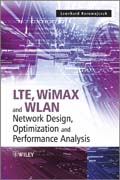
LTE, WiMAX and WLAN network design, optimization and performance analysis
Korowajczuk, Leonhard
A technological overview of LTE and WiMAX LTE, WiMAX and WLAN Network Design,Optimization and Performance Analysis provides a practical guide to LTE and WiMAX technologies introducing various tools and concepts used within. In addition, topics such as traffic modelling of IP-centric networks, RF propagation, fading, mobility, and indoor coverage are explored; new techniques which increase throughput such as MIMO and AAS technology are highlighted; and simulation, network design and performance analysis are also examined. Finally, in the latter part of the book Korowajczuk gives a step-by-step guide to network design, providing readers with the capability to build reliable and robust data networks. By focusing on LTE and WiMAX this book extends current network planningapproaches to next generation wireless systems based on OFDMA, providing an essential resource for engineers and operators of fixed and wireless broadband data access networks. With information presented in a sequential format, LTE, WiMAX and WLAN Network Design, Optimization and Performance Analysis aids a progressive development of knowledge, complementing latter graduate and postgraduate courses while also providing a valuable resource to network designers, equipment vendors, reference material, operators, consultants, and regulators. Key Features: One of the first books to comprehensively explain and evaluate LTE Provides an unique explanation of the basic concepts involved in wireless broadband technologies and their applications in LTE, WiMAX, and WLAN before progressing to the network design Demonstrates the application of network planning for LTE and WiMAX with theoretical and practical approaches Includes all aspects of system design and optimization, such as dynamic traffic simulations, multi-layered traffic analysis, statistical interference analysis, and performance estimations INDICE: List of Figures. List of Tables. About the Author. Preface. Acknowledgements. List of Abbreviations. Introduction. 1 The Business Plan. 1.1 Introduction. 1.2 Market Plan. 1.3 The Engineering Plan. 1.4 The Financial Plan. 1.4.1 Capital Expenditure (CAPEX). 1.4.2 Operational Expenditure (OPEX). 1.4.3Return of Investment (ROI). 1.5 Business Case Questionnaire. 1.6 Implementingthe Business Plan. 2 Data Transmission. 2.1 History of the Internet. 2.2 Network Modeling. 2.3 Internet Network Architecture. 2.3.1 Router. 2.3.2 Hub. 2.3.3 Bridge. 2.3.4 Switch. 2.3.5 Gateway. 2.4 The Physical Layer. 2.4.1 Ethernet PHY. 2.5 The Data Link Layer 2.5.1 Ethernet MAC. 2.6 Network Layer. 2.6.1 Internet Protocol (IP). 2.6.2 Internet Control Message Protocol (ICMP). 2.6.3 Multicast and Internet Group Message. Protocol (IGMP). 2.6.4 Link Layer Control (LLC). 2.7 Transport Protocols. 2.7.1 User Datagram Protocol (UDP). 2.7.2 Transmission Control Protocol (TCP). 2.8 Routing Protocols. 2.8.1 Basic IP Routing. 2.8.2 Routing Algorithms. 2.9 Application Protocols. 2.9.1 Applications. 2.9.2Data Transfer Protocols. 2.9.3 Real Time Protocols. 2.9.4 Network Management Protocols. 2.10 The World Wide Web (WWW). 3 Market Modeling. 3.1 Introduction.3.2 Data Traffic Characterization. 3.2.1 Circuit-Switched Traffic Characterization. 3.2.2 Packet-Switched Traffic Characterization. 3.2.3 Data Speed and Data Tonnage. 3.3 Service Plan (SP) and Service Level Agreement (SLA). 3.4 User Service Classes. 3.5 Applications. 3.5.1 Application Types. 3.5.2 ApplicationsField Data Collection. 3.5.3 Application Characterization. 3.6 Over-Subscription Ratio (OSR). 3.7 Services Summary. 3.8 RF Environment. 3.9 Terminals. 3.9.1 Terminal Types. 3.9.2 Terminal Specification. 3.10 Antenna Height. 3.11 Geographic User Distribution. 3.11.1 Geographic Customer Distribution. 3.11.2 Customers Distribution Layers. 3.12 Network Traffic Modeling. 3.12.1 UnconstrainedBusy Hour Data User Traffic. 3.12.2 Traffic Constraint Factor per Terminal Type. 3.12.3 Expected Number of Users per Terminal Type. 3.12.4 Busy Hour Traffic per Subscription. 3.12.5 Daily Traffic per Subscription. 3.12.6 Service PlanTonnage Ranges. 3.12.7 Number of Subscriptions per Service Plan. 3.12.8 TotalNumber of Users. 3.12.9 Mapping of Portable Terminal Users (MPU). 3.12.10 Users Area Mapping. 3.12.11 Hourly Traffic Variation. 3.12.12 Prediction Service Classes (PSC). 3.12.13 Traffic Layers Composition. 3.12.14 Network Traffic perLayer. 3.13 KPI (Key Performance Indicator) Establishment. 3.14 Wireless Infrastructure. 4 Signal Processing Fundamentals. 4.1 Digitizing Analog Signals. 4.2 Digital Data Representation in the Frequency Domain (Spectrum). 4.3 Orthogonal Signals. 4.3.1 Sine and Cosine Orthogonality. 4.3.2 Harmonically Related Signals Orthogonality. 4.4 Combining Shifted Copies of a Sine Wave. 4.5 CarrierModulation. 5 RF Channel Analysis. 5.1 The Signal. 5.2 The RF Channel. 5.3 RFSignal Propagation. 5.3.1 Free Space Loss. 5
- ISBN: 978-0-470-74149-8
- Editorial: John Wiley & Sons
- Encuadernacion: Rústica
- Páginas: 784
- Fecha Publicación: 29/07/2011
- Nº Volúmenes: 1
- Idioma: Inglés
